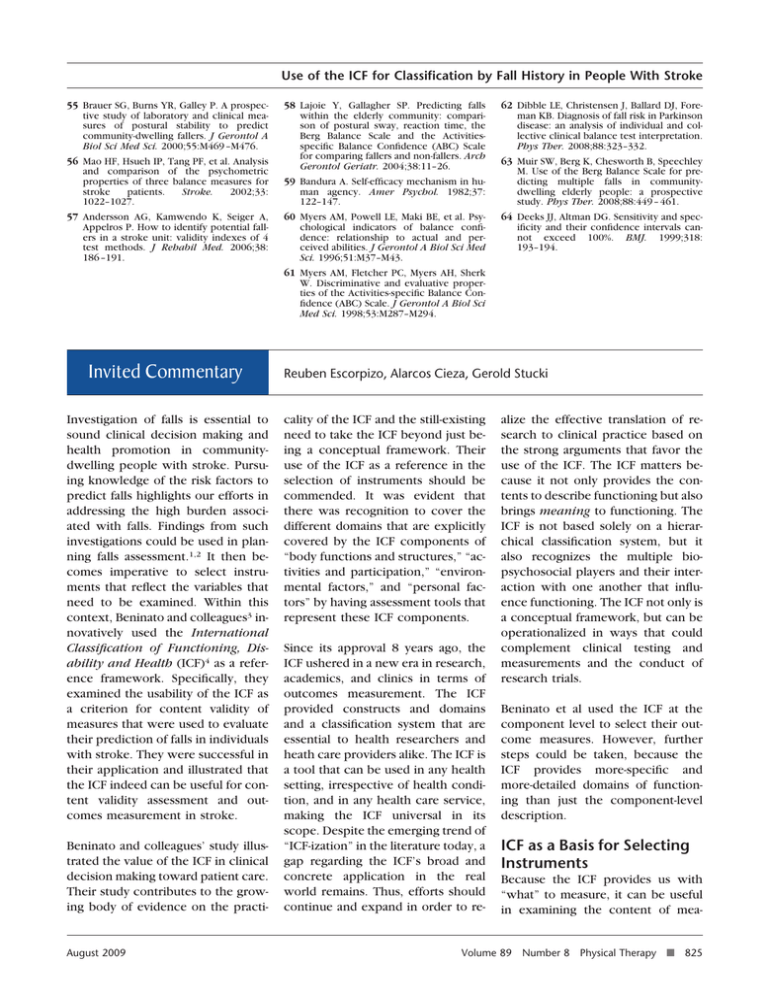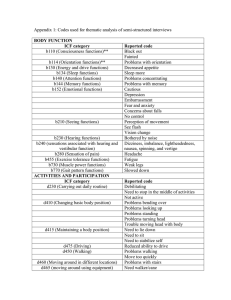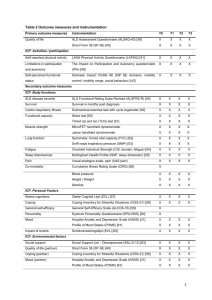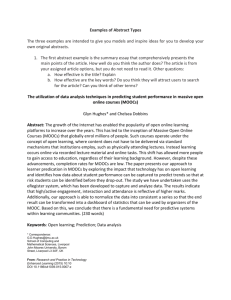55 58 62 tive study of laboratory and clinical mea-
advertisement

Use of the ICF for Classification by Fall History in People With Stroke 55 Brauer SG, Burns YR, Galley P. A prospective study of laboratory and clinical measures of postural stability to predict community-dwelling fallers. J Gerontol A Biol Sci Med Sci. 2000;55:M469 –M476. 56 Mao HF, Hsueh IP, Tang PF, et al. Analysis and comparison of the psychometric properties of three balance measures for stroke patients. Stroke. 2002;33: 1022–1027. 57 Andersson AG, Kamwendo K, Seiger A, Appelros P. How to identify potential fallers in a stroke unit: validity indexes of 4 test methods. J Rehabil Med. 2006;38: 186 –191. Invited Commentary Investigation of falls is essential to sound clinical decision making and health promotion in communitydwelling people with stroke. Pursuing knowledge of the risk factors to predict falls highlights our efforts in addressing the high burden associated with falls. Findings from such investigations could be used in planning falls assessment.1,2 It then becomes imperative to select instruments that reflect the variables that need to be examined. Within this context, Beninato and colleagues3 innovatively used the International Classification of Functioning, Disability and Health (ICF)4 as a reference framework. Specifically, they examined the usability of the ICF as a criterion for content validity of measures that were used to evaluate their prediction of falls in individuals with stroke. They were successful in their application and illustrated that the ICF indeed can be useful for content validity assessment and outcomes measurement in stroke. Beninato and colleagues’ study illustrated the value of the ICF in clinical decision making toward patient care. Their study contributes to the growing body of evidence on the practi- August 2009 58 Lajoie Y, Gallagher SP. Predicting falls within the elderly community: comparison of postural sway, reaction time, the Berg Balance Scale and the Activitiesspecific Balance Confidence (ABC) Scale for comparing fallers and non-fallers. Arch Gerontol Geriatr. 2004;38:11–26. 59 Bandura A. Self-efficacy mechanism in human agency. Amer Psychol. 1982;37: 122–147. 60 Myers AM, Powell LE, Maki BE, et al. Psychological indicators of balance confidence: relationship to actual and perceived abilities. J Gerontol A Biol Sci Med Sci. 1996;51:M37–M43. 61 Myers AM, Fletcher PC, Myers AH, Sherk W. Discriminative and evaluative properties of the Activities-specific Balance Confidence (ABC) Scale. J Gerontol A Biol Sci Med Sci. 1998;53:M287–M294. 62 Dibble LE, Christensen J, Ballard DJ, Foreman KB. Diagnosis of fall risk in Parkinson disease: an analysis of individual and collective clinical balance test interpretation. Phys Ther. 2008;88:323–332. 63 Muir SW, Berg K, Chesworth B, Speechley M. Use of the Berg Balance Scale for predicting multiple falls in communitydwelling elderly people: a prospective study. Phys Ther. 2008;88:449 – 461. 64 Deeks JJ, Altman DG. Sensitivity and specificity and their confidence intervals cannot exceed 100%. BMJ. 1999;318: 193–194. Reuben Escorpizo, Alarcos Cieza, Gerold Stucki cality of the ICF and the still-existing need to take the ICF beyond just being a conceptual framework. Their use of the ICF as a reference in the selection of instruments should be commended. It was evident that there was recognition to cover the different domains that are explicitly covered by the ICF components of “body functions and structures,” “activities and participation,” “environmental factors,” and “personal factors” by having assessment tools that represent these ICF components. Since its approval 8 years ago, the ICF ushered in a new era in research, academics, and clinics in terms of outcomes measurement. The ICF provided constructs and domains and a classification system that are essential to health researchers and heath care providers alike. The ICF is a tool that can be used in any health setting, irrespective of health condition, and in any health care service, making the ICF universal in its scope. Despite the emerging trend of “ICF-ization” in the literature today, a gap regarding the ICF’s broad and concrete application in the real world remains. Thus, efforts should continue and expand in order to re- alize the effective translation of research to clinical practice based on the strong arguments that favor the use of the ICF. The ICF matters because it not only provides the contents to describe functioning but also brings meaning to functioning. The ICF is not based solely on a hierarchical classification system, but it also recognizes the multiple biopsychosocial players and their interaction with one another that influence functioning. The ICF not only is a conceptual framework, but can be operationalized in ways that could complement clinical testing and measurements and the conduct of research trials. Beninato et al used the ICF at the component level to select their outcome measures. However, further steps could be taken, because the ICF provides more-specific and more-detailed domains of functioning than just the component-level description. ICF as a Basis for Selecting Instruments Because the ICF provides us with “what” to measure, it can be useful in examining the content of mea- Volume 89 Number 8 Physical Therapy f 825 Use of the ICF for Classification by Fall History in People With Stroke sures or tests (ie, content validity). The selection can be made based on: (1) content examination of measures (eg, questionnaires) through ICF linking methodology,5 (2) existing health condition–specific Core Sets6 such as that for stroke, or (3) the generic core set. It is worthwhile to mention that there have been studies that dealt with ICF-based outcomes measurement in stroke. For example, the ICF Core Sets for stroke, consisting of 130 categories mostly from the “activities and participation” and “body functions and structures” components have been developed7 and are being validated. Another study compared the contents of measures of health-related quality of life in stroke and found that there is wide variety of measures in terms of their contents (ie, health domains).8 Although there are ways by which the ICF can help us select instruments to use, the decision would depend largely on the aim of the study and, as in Beninato and colleagues’ study, determining whether the selected measures (and their contents) do predict the occurrence of falls. To illustrate this further, let us look at 2 of the instruments that were used in the study by Beninato and colleagues. First, the selection of the Berg Balance Scale (BBS)9 to represent the “activities (and participation)” domain is consistent with a study by Schepers et al10 that identified the BBS to contain concepts mainly linked to “mobility” (d4), which includes transfers and maintaining and changing body positions. Mobility, however, also comprises major content of other stroke measures10 such as the Frenchay Activities Index (FAI).11 The BBS appears to be almost unidimensional to mobility, that if the “activities and participation” component of the FAI, in accordance with the ICF’s definition, were to include social participation, such as work (employment), home (household), and other societal 826 f Physical Therapy Volume 89 roles,4 then the FAI might be able to capture that information better. Second, we are unsure whether the Activities-specific Balance Confidence (ABC) Scale12 represents only personal factors. The ABC Scale comprises multiple items that, if formally linked to the ICF, most likely would contain ICF categories that are relevant to the “activities and participation” component such as “walking” (d450), “changing basic body position” (d410), “reaching” (d4452), and so on. Some of the ABC Scale items include self-confidence in engaging with “escalators” and “icy sidewalks,” which as such also could be linked to the “environmental factors” component, such as “products and technology of buildings for public use” (e150) and “private use” (e155). Moreover, the choice of instrument becomes critical because not only do we want to make sure that the contents specific to the event of interest are being reflected, but we want to make sure that other psychometric considerations are kept in mind. For example, the Nottingham Health Profile (NHP)13 had the most links to the “body function” component of the ICF.10 However, the NHP may lack responsiveness.14 Having said this, content examination studies are not meant to be strict guidelines but are meant to provide researchers with options as to whether or not an instrument, based on what it contains, can give researchers moreappropriate representation of the domains or constructs that they want and intend to measure. Selection of instruments can be made according to what constructs or measures are included in existing ICF Core Sets for specific health conditions such as stroke or according to studies that have examined the contents of existing measures used in stroke. The ICF could provide insights into content validity, and other properties such as reliability, construct and predictive Number 8 validity, and responsiveness are just as important in outcome measurement. In this regard, the ICF becomes a complementary system or reference. Conclusion A fundamental process is to perform content analysis of measures based on the ICF, which can be accomplished through referral to existing Core Sets or by performing a linking exercise.5 A parallel effort would be to investigate whether those ICF categories identified in those measures do predict falls. For example, difficulty in stooping and kneeling was most significantly associated with falls in individuals with stroke.1 Stooping or bending and kneeling are linked to the ICF category d410 (“changing basic body position”).4 Simply stated, if one were interested in looking at these 2 activities (stooping and kneeling) to predict falls, then one would look into measures that contain them such as the BBS and the Rivermead Motor Assessment.15 Beninato et al discussed the existing differences in contents of different outcome measures and the different findings on the measures’ associations with falls. We believe that ICF can serve as a unifying reference in examining the contents and looking at categories (ICF) that are predictive of or associated with falls. Beninato and colleagues’ study was well performed and can be used as a use case toward the integration of the ICF language in conducting studies. Their study showed the ICF as a reference for the planning of study and selection of instruments. They chose to represent functioning relevant domains to investigate falls in individuals with stroke at the level of the ICF components, while looking closely at whether the instruments they used may actually reveal that the contents of these instruments are not exclusive to a single component August 2009 Use of the ICF for Classification by Fall History in People With Stroke and may actually cover multiple components, making the distinction among components difficult. Thus, the representation by component level only may not be adequate enough to tease out specific constructs of functioning that are contained at the chapter and category levels of the ICF. Perhaps, accuracy for the prediction of falls may even vary according to categories and not components. The authors could have gone beyond by selecting instruments based on Core Sets or content analysis of instruments at a level more specific than the component level. Falls indeed are related to multiple factors that cannot be explored only by using a single outcome measure but rather must be explored with sets of outcome measures—an insight shared by Beninato and colleagues. Amid the differences in outcome measurement, we believe that the ICF could serve as a frame of reference in this regard and could provide us with health domains relevant to a specific population or specific health condition or healthrelated event. Selections of ICF categories and domains, such as the ICF Core Sets, can be the basis for creating a “categorical profile” of the population of interest and also for defining intervention targets. The ICF’s integration into health care also can be realized significantly if used as a taxonomy basis for designing and reporting studies and ICF coding of outcome measures using the Core Sets. To further foster the use of the ICF, it also could serve as a reference Author Response We appreciate the comments of Escorpizo, Cieza, and Stucki1 on our article,2 in which we used the components of the International ClassiAugust 2009 for reporting of studies in journals in the future. R. Escorpizo, PT, DPT, is Project Leader, ICF Research Branch of WHO Collaborating Center for the Family of International Classifications at the German Institute of Medical Documentation and Information (DIMDI), Swiss Paraplegic Research (SPF), Nottwil, Switzerland. A. Cieza, PhD, is Senior Scientist, Swiss Paraplegic Research (SPF), Nottwil, Switzerland, and ICF Research Branch of the WHO CC FIC (DIMDI), IHRS, Ludwig-Maximilian University, Munich, Germany, and Swiss Paraplegic Research, Nottwil, Switzerland. G. Stucki, MD, is Director of Swiss Paraplegic Research (SPF), Nottwil, Switzerland; Professor and Chairman, Department of Physical Medicine and Rehabilitation, LudwigMaximilian University; Director of the ICF Research Branch of the WHO CC FIC (DIMDI), IHRS, Ludwig-Maximilian University and Swiss Paraplegic Research, Nottwil, Switzerland; and Professor and Chair of the Seminar of Health Sciences and Health Policy, University of Lucerne, Lucerne, Switzerland. SPF: Guido A Zäch Strasse 4, 6207 Nottwil, Switzerland. Address all correspondence to Professor Stucki at: gerold.stucki@ paranet.ch. DOI: 10.2522/ptj.20080160.ic References 1 Mackintosh SF, Goldie P, Hill K. Falls incidence and factors associated with falling in older, community-dwelling, chronic stroke survivors (1 year after stroke) and matched controls. Aging Clin Exp Res. 2005;17:74 – 81. 2 Forster A, Young J. Incidence and consequences of falls due to stroke: a systematic inquiry. BMJ. 1995;311:83– 86. 3 Beninato M, Portney LG, Sullivan PE. Using the International Classification of Functioning, Disability and Health as a framework to examine the association between falls and clinical assessment tools in people with stroke. Phys Ther. 2009;89: 816 – 825. 4 International Classification of Functioning, Disability and Health: ICF. Geneva, Switzerland: World Health Organization; 2001. 5 Cieza A, Geyh S, Chatterji S, et al. ICF linking rules: an update based on lessons learned. J Rehabil Med. 2005;37: 212–218. 6 Cieza A, Ewert T, Üstün B, et al. Development of ICF core sets for patients with chronic conditions. J Rehabil Med Suppl. 2004;36:9 –11. 7 Geyh S, Cieza A, Schouten J, et al. ICF core sets for stroke. J Rehabil Med. 2004;(44 suppl):135–141. 8 Geyh S, Cieza A, Kollerits B, et al. Content comparison of health-related quality of life measures used in stroke based on the International Classification of Functioning, Disability and Health (ICF): a systematic review. Qual Life Res. 2007;16: 833– 851. 9 Berg KO, Wood-Dauphinée SL, Williams JI, Maki B. Measuring balance in the elderly: validation of an instrument. Can J Public Health. 1992;83(suppl 2):S7–S11. 10 Schepers VP, Ketelaar M, van de Port IG, et al. Comparing contents of functional outcome measures in stroke rehabilitation using the International Classification of Functioning, Disability and Health. Disabil Rehabil. 2007;29:221–230. 11 Holbrook M, Skilbeck CE. An activities index for use with stroke patients. Age Ageing. 1983;12:166 –170. 12 Powell LE, Myers AM. The Activitiesspecific Balance Confidence (ABC) Scale. J Gerontol A Biol Sci Med Sci. 1995;50: M28-M34. 13 Hunt SM, McEwen J. The development of a subjective health indicator. Sociol Health Illn. 1980;2:231–246. 14 Salter K, Jutai JW, Teasell R, et al. Issues for selection of outcome measures in stroke rehabilitation: ICF participation. Disabil Rehabil. 2005;27:507–528. 15 Lincoln N, Leadbitter D. Assessment of motor function in stroke patients. Physiotherapy. 1979;65:48 –51. Marianne Beninato, Leslie G. Portney, Patricia E. Sullivan fication of Functioning, Disability and Health (ICF)3 as a framework to categorize clinical measures as we explored their accuracy in identify- ing people with stroke according to fall history. We found the ICF framework practical and useful for this purpose, as the model brings mean- Volume 89 Number 8 Physical Therapy f 827







